The Fed funds rate and mortgage rates have an indirect yet important connection. Although they operate differently and affect distinct areas of the economy, the Federal funds rate can impact borrowing costs, which can eventually influence mortgage rates – not always, but nonetheless, important to note.
While the Federal Reserve’s actions can indirectly influence mortgage rates, there isn’t a direct one-to-one relationship between the Fed funds rate cuts and mortgage rates. Understanding this relationship can lead to more informed decisions about investments and mortgages.
At Defy Mortgage, we offer over 75 tailored lending solutions for all types of borrowers, from non-QM loans like bank statement loans and P&L loans to large-scale financing products like jumbo loans and DSCR loans. Whatever your borrowing needs, our mortgage experts can customize a solution that works for you.
Given our extensive list of lending options, we’re responsible for staying updated on the Federal funds rate and its impact on our services. In this blog, we’ll highlight the key differences between the Federal funds rate and mortgage rates. We’ll also explain the mechanisms through which the Federal funds rate influences mortgage rates.
Let’s dive in.
What Is the Fed Funds Rate?
Separating fact from fiction is crucial here to begin. Many people assume that when the Federal Reserve cuts its benchmark interest rate, mortgage rates will automatically follow suit. However, this is a significant oversimplification of how interest rates work in practice.
The Federal Reserve’s benchmark rate (the federal funds rate) primarily affects short-term borrowing, such as credit cards and some business loans. Mortgage rates, on the other hand, are more closely tied to the 10-year Treasury yield and broader market forces, including inflation expectations, overall economic conditions, housing market health and more. We will dive deeper into the key differences shortly.
To understand the link between the Fed funds rate and mortgage rates, it’s important to know that the Fed funds rate is the interest rate banks charge each other for short-term loans, as directed by the Federal Reserve. This rate can sometimes influence broader lending and economic activity, including mortgage rates. This is why the Fed funds rate can lead to higher monthly mortgage payments however, they are not mutually exclusive. In fact, interest rates can increase from a Fed rate cut.
How the Fed Funds Rate Works: A Deeper Look
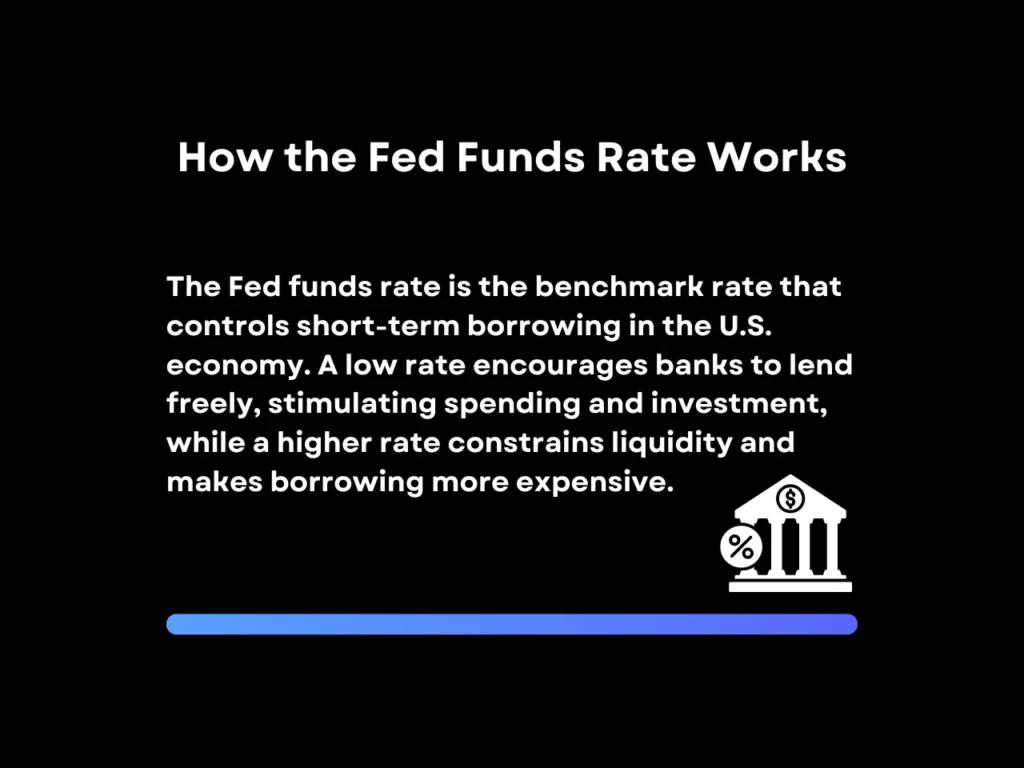
The Fed funds rate is the central benchmark rate connected to several key mechanisms in the United States economy, making it arguably the backbone of the U.S. financial system. The Federal Reserve System essentially uses it as a lever that controls short-term borrowing across the economy. Short-term borrowing involves any type of loan meant to meet immediate needs and is intended to be paid off quickly, such as credit card debt.
Specifically, the Fed funds rate defines the rate for interbank lending, where banks with excess reserves lend to those falling short of their required reserves. These reserves are held to cover client withdrawals, and banks must legally maintain a set percentage based on client deposits.
When banks fall short of required reserves, they must take out an overnight loan from other banks, and the Fed funds rate determines the interest on these loans. A low Fed funds rate provides banks with cheaper funding, encouraging lending to businesses and consumers, which boosts spending and investment across the country’s economy.
Conversely, a higher Fed funds rate tightens bank liquidity, making borrowing more costly and leading to stricter lending standards, which limits credit availability for borrowers. This balance directly impacts the overall flow of money in the economy.
Why Is the Fed Funds Rate Important?
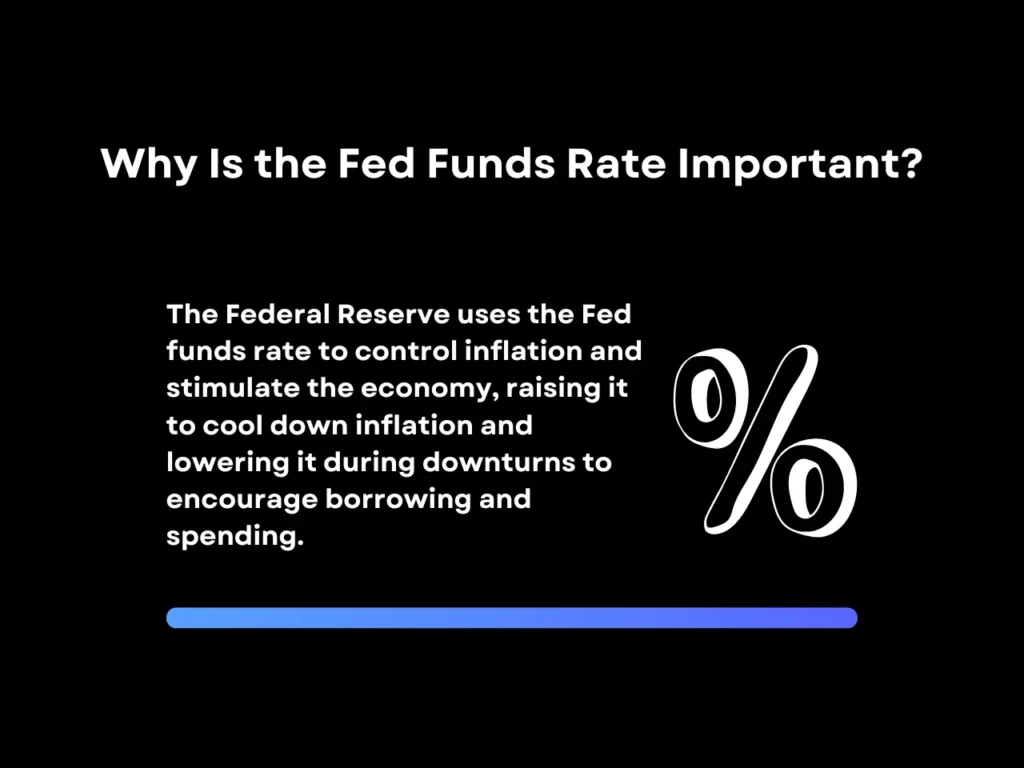
The Federal Reserve operates with a dual mandate: maximizing employment and stabilizing prices. It uses the Fed funds rate to manage inflation and stimulate the economy as needed. When inflation rises too quickly, the Fed increases the Fed funds rate to slow the economy. A higher Fed rate raises borrowing costs for banks, which in turn discourages spending, reduces demand, and helps curb inflation.
Conversely, decreasing the Fed rate can be invaluable during economic downturns, such as recessions. By reducing borrowing costs, the Fed encourages businesses to expand, consumers to spend more, and investors to seek higher-yield opportunities, even if they carry greater risk. This boost in market activity helps stimulate economic growth.
The Fed funds rate can also influence employment levels, as lower rates encourage companies to expand, leading to increased hiring. However, if kept too low for too long, especially through strong economic growth, it can cause an overheated economy. This creates an unsustainable rate, creating labor demand that cannot be fulfilled and wage inflation.
In essence, the Fed funds rate is a tool for economic balance. Through it, the Federal Reserve manages liquidity and borrowing costs, which are key to the financial health of both individual institutions and the broader economy.
Financial Products Affected by the Fed Funds Rate
Mortgage rates, for instance, don’t simply follow Fed rates in a straight line. The relationship is more complicated. Just because the Fed cuts rates doesn’t guarantee that mortgage rates will keep falling.
Many major financial products used by millions of US consumers can be tied in some ways to the Fed funds rate, even if not directly, including:
- Credit Card Rates: Many credit card companies base their rates on the prime rate, which follows the Federal funds rate. When the Fed raises the Fed funds rate, credit card interest typically increases.
- Short-Term Consumer Loans: Short-term loans like auto loans and personal loans are sensitive to the Fed funds rate hike, making them more expensive to repay over 5 years.
- Corporate or Business Loans: Businesses frequently take out loans for capital investment and day-to-day operations. The Fed funds rate directly influences the cost of these loans. A lower rate means cheaper access to capital, which can drive business expansion. Higher rates, however, can lead to cost-cutting and reduced growth.
The Federal Funds Rate vs. The Discount Rate vs. The Prime Rate
The discount rate and prime rate stand alongside the Federal funds rate as key financial benchmarks. Here is how they differ from the Federal funds rate.
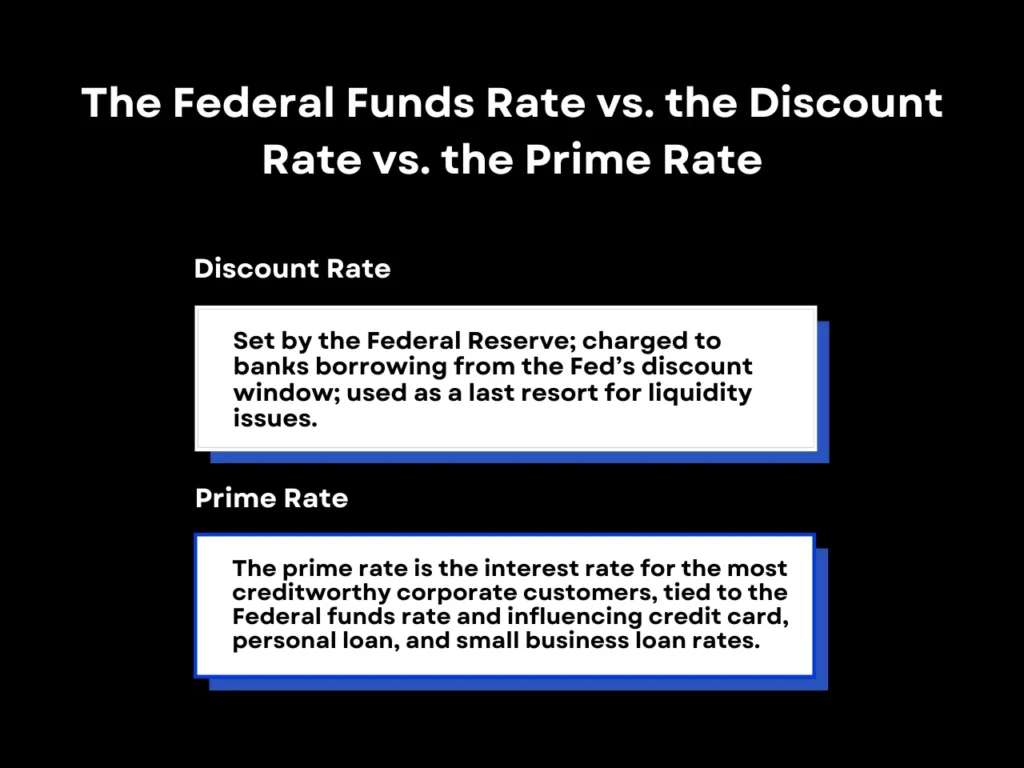
Discount Rate
The discount rate is the interest rate that the Federal Reserve charges banks when they borrow money directly from the Fed’s discount window, which is the Fed’s own lending facility. This is usually a last resort for banks, reserved only for when they are experiencing liquidity issues or having difficulty meeting their reserve requirements.
One key difference between the discount rate vs the Federal funds rate is that the Fed funds rate is adjusted in response to current market dynamics, while the discount rate is set explicitly by the Federal Reserve to enforce its monetary policy. A lower discount rate encourages borrowing to stimulate economic activity, while a higher rate signals that the Fed is tightening financial conditions.
Prime Rate
The prime rate is the interest rate that commercial banks, like Bank of America, charge their most creditworthy corporate customers. It represents the lowest rate available, typically reserved for the least risky borrowers.
Prime rates are directly linked to the Federal funds rate, with banks adjusting their prime rate based on the changes in the Fed funds rate. This, in turn, serves as the starting point for the other interest rates banks offer, such as those for credit cards, personal loans, and small business loans.
How the Fed Funds Rate Influences Mortgage Rates
Although the Fed funds rate primarily influences short-term interest rates, it does have an indirect relationship with mortgage rates. Mortgage rates depend on longer-term financial instruments like Treasury yields and the bond market. Fed policy changes such as Fed rate cuts can create a ripple effect that alters the performance of these financial instruments, thus influencing mortgage rates as well.
How the Fed Funds Rate Affects Mortgage Rates Through Treasury Yields
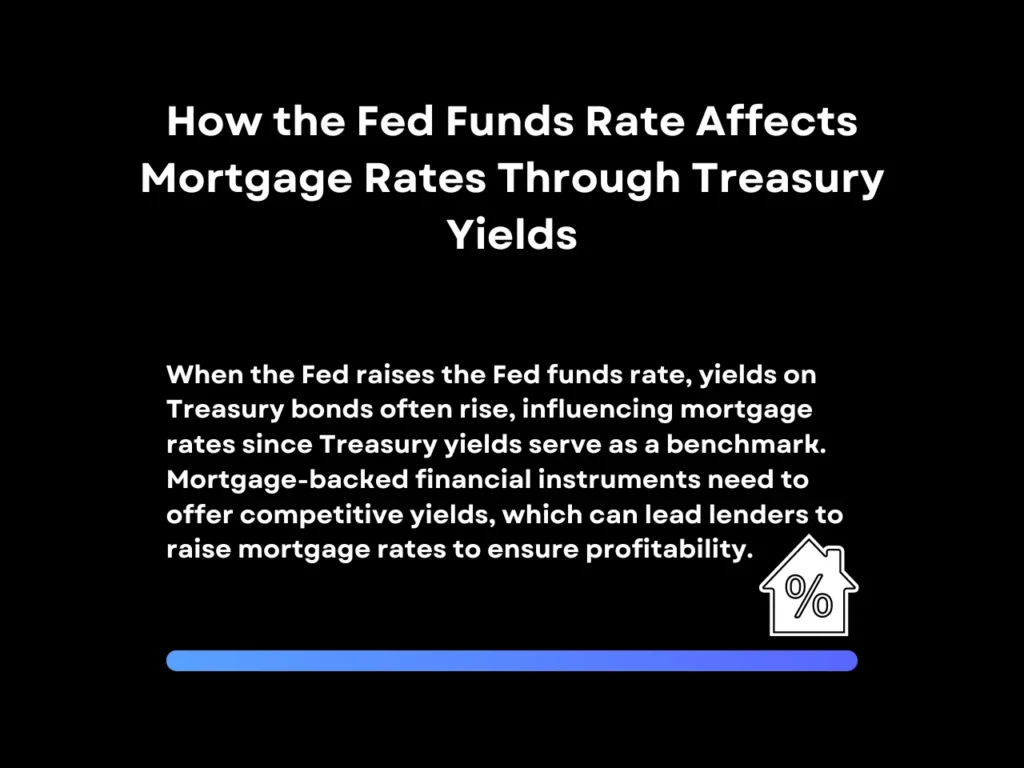
Fixed-rate mortgages are closely tied to the 10-year Treasury yield, as this benchmark rate serves as merely a key indicator for the fixed-rate mortgage market. When the Fed raises the Fed funds rate, yields on Treasury bonds can rise. Treasury bond yields are often used as a benchmark for setting mortgage rates because mortgage-backed investments need to compete with them. Treasury bonds take only 10 years to mature as opposed to 30 for mortgages, making them safer investments. However, it’s important to note that the fixed mortgage rate is not exactly the same as the 10-year Treasury yield – there is typically a gap between the two rates.
Mortgage lenders require liquidity to offer loans to borrowers. One way to generate this liquidity is by selling mortgage-backed financial instruments, such as mortgage-backed securities and mortgage bonds. These investments promise returns once the mortgage is fully paid off, which can take up to 30 years or more.
With such a long timeline, the likelihood of the investment going bad increases, especially if economic conditions force borrowers to default on their loans. These losses are generally passed on to the investor, and the actual real estate assets in a mortgage-backed instrument can’t always be sold back on the market to recoup the cost.
This means that mortgage-backed financial instruments must offer more competitive yields to stay appealing to borrowers. As a result, lenders may increase mortgage rates to enhance returns on these securities. However, the relationship isn’t always linear. Other market conditions, such as investor sentiment and the housing market’s health, also play significant roles in determining mortgage rates.
Key Differences Between the Two Rates
Although the Fed funds rate and mortgage rates are connected, they serve different purposes and are determined by distinct mechanisms. Here are the most important differences between the Fed funds rate and mortgage rates.
This explains why Fed rate changes don’t directly translate to mortgage rate changes – they operate in different markets with different influences and timeframes. Take a look:
| Fed Funds Rate | Mortgage Rates | |
| Duration | Short-term (can change up to 8 times a year). | Long-term (15-30 years or more, unless adjustable-rate or if the borrower refinances) |
| Purpose | Controlling liquidity in the banking system to influence overall economic activity. | Interest rate that consumers pay on home loans, which is how mortgage lenders and their investors turn a profit. |
| Who It Affects | Primarily banks and other financial institutions. | Directly impact consumers looking to purchase or refinance, as well as real estate investors whose returns depend on mortgage profits. |
| Change Frequency | FOMC meetings (which happen a certain times each year – usually 8) | Daily/Market-driven |
| How Rates are Set | Directly set by the Federal Reserve through its policy-making process, usually in response to economic conditions. | Determined by several economic factors, with Treasury yields (10-yr) as a key indicator. Demand for returns on mortgage-backed investments, inflation, housing market supply and demand, and overall economic health all contribute. |
What Happens When Mortgage Interest Rates Drop
Let’s quickly move away from the Fed funds rate and mortgage rates for a moment. When mortgage interest rates decline, it creates a favorable environment for both current homeowners and potential buyers. Existing homeowners may find their monthly mortgage payments reduced, while new entrants to the housing market may discover increased affordability. This scenario often triggers several market responses:
- Surge in refinancing: Many homeowners seize the opportunity to refinance their existing mortgages, potentially lowering their monthly payments. Initially, when there is news about the Fed cutting interest rates, you’ll see a lot of articles and new pieces surrounding refinancing, rate-and-term refinancing and cash-out refinancing.
- Enhanced home affordability: The reduced cost of borrowing translates to lower monthly payments for the same loan amount, effectively making home purchases more accessible to a wider range of buyers including real estate investors looking to expand their portfolio, first-time home buyers, homeowners looking to move or purchase a second property, etc.
- Stimulated housing market: The combination of more affordable financing and increased buyer interest typically leads to heightened activity in the real estate market. This often manifests as an uptick in home sales and overall market dynamism.
- Broader financial opportunities: For those refinancing, the prospect of lower monthly payments opens up possibilities for redirecting funds to other financial goals or investments.
This financial landscape presents opportunities for various stakeholders in the housing market looking to optimize their mortgage terms.
Fed Funds Rate and Mortgage Rates FAQs
How Often Does the Fed Change the Fed Funds Rate, and How Quickly Do Mortgage Rates Respond?
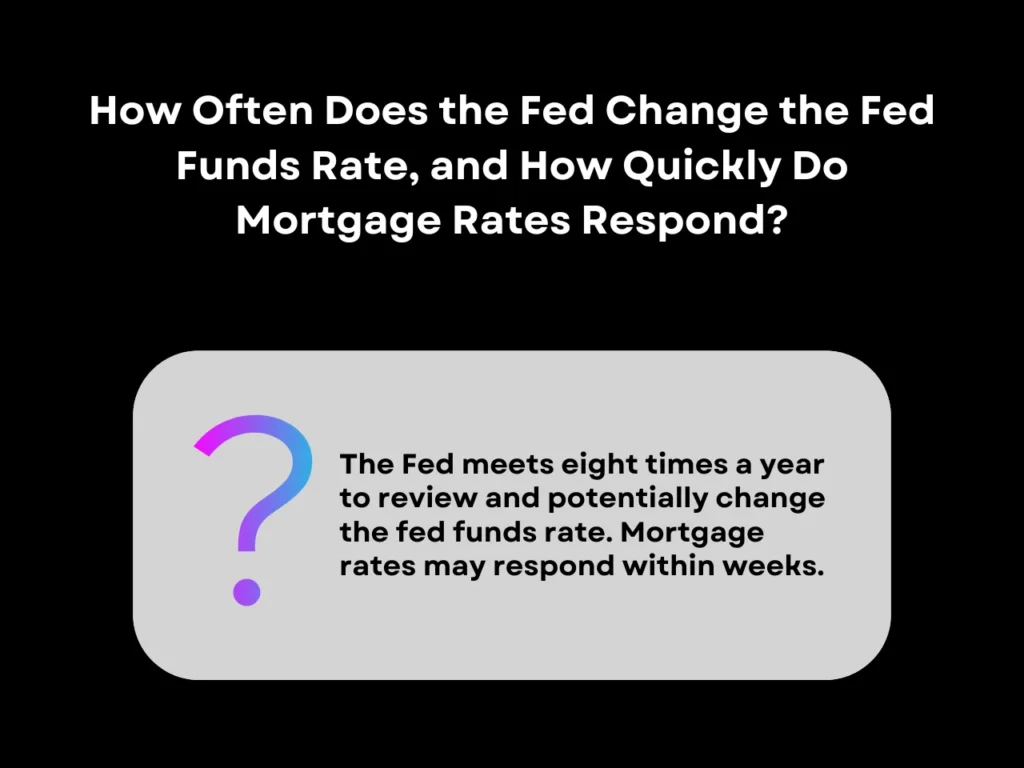
The Fed reviews and may change the Fed funds rate eight times a year. Mortgage rates typically adjust within weeks but can also move independently based on broader economic factors.
Are Mortgage Rates Always Influenced by Changes in the Fed Funds Rate?
No. The Fed funds rate and mortgage rates are not directly correlated. While the fed funds rate indirectly influences mortgage rates, other factors such as inflation, market demand, and bond yields can also affect them.
Can Mortgage Rates Rise Even if the Fed Funds Rate Stays the Same?
Yes. Mortgage rates can increase due to other market conditions like rising Treasury yields, inflation, or investor expectations.
How Does Inflation Impact Both the Fed Funds Rate and Mortgage Rates?
Inflation erodes purchasing power, prompting the Fed to raise the fed funds rate to control it. Higher inflation can also push mortgage rates up as investors demand higher returns to offset the diminishing value of future repayments.
Should I Refinance My Mortgage When the Fed Funds Rate Is low?
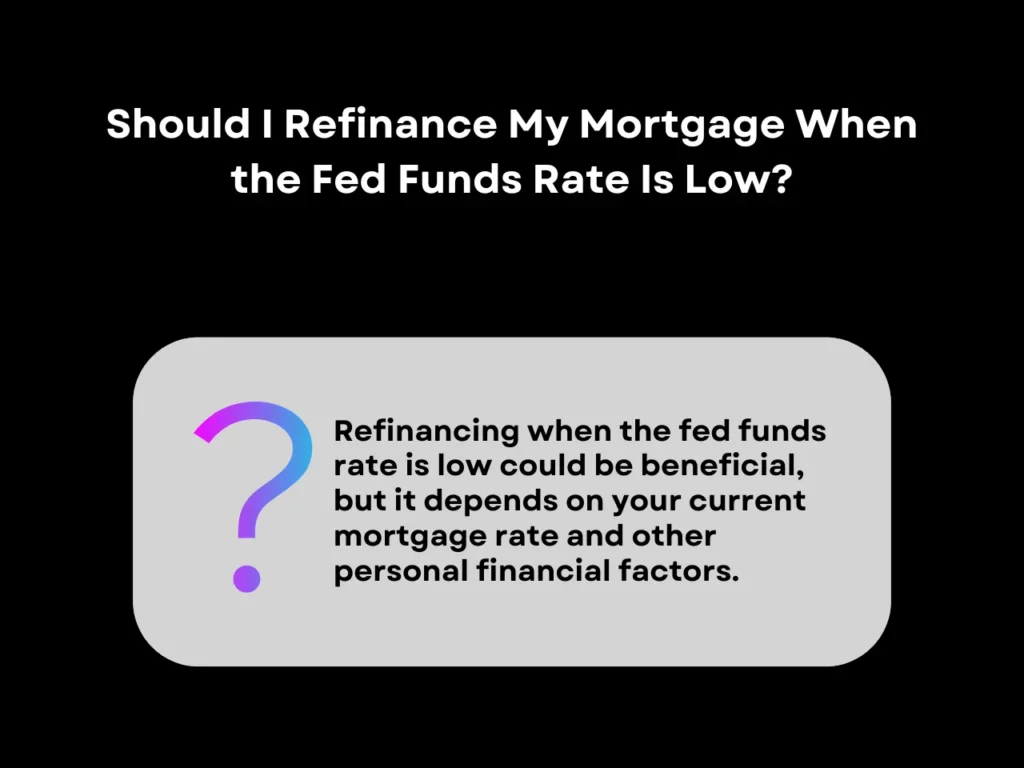
Refinancing when the Fed funds rate is low could be beneficial, but it depends on your current mortgage rate and other personal financial factors. Low Fed funds rates often lead to lower mortgage rates, but always consider closing costs and your long-term financial goals.
Key Takeaway
As the primary tool of U.S. monetary policy, the Federal funds rate influences many interest rates across the economy. While its direct impact on mortgage rates is limited, mortgage rates are still affected indirectly by long-term factors like government securities yields and economic outlook. This connection allows the Fed funds rate to influence mortgage rates as well, but the effect occurs through multiple economic channels before it reaches the housing market.
Understanding the differences between the Fed funds rate and mortgage rates and their relationship is crucial for making smart financial decisions. Mortgage rates are attached to several determiners, including market sentiment and financial indices. Although tracking these factors can be complex, the Fed funds rate is a good rule of thumb to gauge the direction mortgage rates are going.Interested in learning more about your mortgage options in light of the new Federal funds rate? Reach out to Defy today and let our team give you expert advice. Whether you’re a self-employed individual, entrepreneur, real estate investor, or homeowner, our seamless platform can give you fast access to quality financing.







